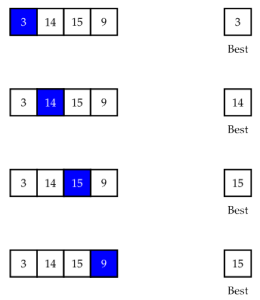Hello everyone!
Sorry for missing last week's post. I was a bit busy graduating. It shouldn't happen again.
I mentioned back in my first post that one of my interests is algorithm design. This week, I'd like to talk a bit about what that means. The word "algorithm" gets thrown around a lot in TV shows, movies, and science journalism, and quite often, it's horribly misused. So let's define our terms before we go further: an algorithm is a sequence of steps which can be followed to turn one form of data into another.
That's kind of an abstract definition, though, so let's dive in with an example. Let's say we have a list of numbers, and we'd like to know which is the largest. How might we go about this? One way to do this is to just walk through the list and keep track of the largest number we've seen. So in the list below, we start by saying the  is the largest number. Next, we check the
is the largest number. Next, we check the  and see that it's larger than
and see that it's larger than  , so it's the largest so far. We then check the
, so it's the largest so far. We then check the  and see that it's even larger. Finally, we see that the
and see that it's even larger. Finally, we see that the  isn't larger, so
isn't larger, so  is still the largest we've seen.
is still the largest we've seen.







